|
Nameplates |
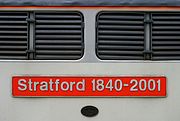 |
31271's Stratford 1840-2001 nameplate, pictured while the loco was in Corwen station, on the Llangollen Railway, on 9 July 2023. The loco was named at the 2004 Railfest event at York, as mentioned on the small plaque. The nameplates previously had a light blue background. |
|
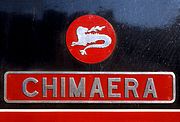 |
31602 received the name Chimaera on 16 June 1999. The nameplate and striking Chimaera logo are pictured a couple of months later, on 22 August 1999 at Ridgmont. In Greek mythology the Chimera was a fire breathing hybrid animal, but the name has come to mean anything 'wildly imaginative, implausible, or dazzling'. Surely that can't be a Class 31! |
|
 |
33051 Shakespeare Cliff's nameplate is pictured in the afternoon sun at Scarborough on 15 February 1997. Note the way the 'Dutch' colour scheme has been applied on top of the previous paintwork, without any rubbing down, revealing some quite serious peeling of the previous paint! |
|
 |
33116 was named Hertfordshire Rail Tours by John Farrow and Ian Kapur of Hertfordshire Rail Tours at Weymouth in December 1993. One of the nameplates is seen here whilst the loco was at Scarborough on 15 February 1997. |
|
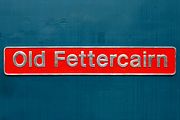 |
Och, I'll have a wee dram! 37097 received the name Old Fettercairn on 5 May 2007 at Brechin station, on the Caledonian Railway. It was named by the managing director of the Fettercairn Distillery, and is recognition of the distillery's financial help with the loco's restoration. It is pictured here at Bridge of Dun on 4 May 2008. |
|
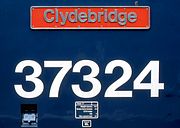 |
37324's Clydebridge nameplate, picture on 5 October 2002, when it was a persevered loco at the Gloucestershire Warwickshire Railway at Toddington. The loco has since been acquired by Colas, and has reverted to its earlier 37099 number. |
|
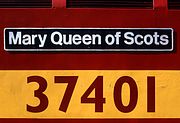 |
37401 was named Mary Queen of Scots at the appropriately Scottish location of Linlithgow on 4 November 1985. Here is the weather beaten nameplate pictured on 20 July 200 at the slightly less appropriate location of Caerphilly. |
|
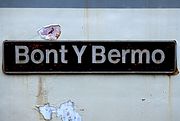 |
37402 Bont-Y-Bermo was to wait until the following year for a repaint when this photo of its nameplate was taken at Llanishen on 15 July 2002. Clearly it needed a repaint, with several areas of rust showing through the paint. 37402 received its name on 10 February 1994, the name having previously been carried by 37427. When on 37427, the plates had a red backing, and traces of the original paint are showing through the black paint. Bont-Y-Bermo is Welsh for Barmouth Bridge. |
|
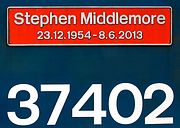 |
37402 was named Stephen Middlemore 23.12.1954 - 8.6.2013 to commemorate one of DRS's employees. The nameplate is pictured on 19 June 2019, whilst the loco was stopped in Charlbury station, as it worked the 2Z02 08:23 Reading to Reading inspection saloon. |
|
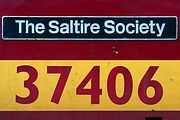 |
37406 received the name The Saltire Society at Eastfield depot on 26 June 1986. The Saltire Society basically promotes all things Scottish, and although 37406 was a Scottish machine when the name was applied, it has subsequently spent large periods of time working in Wales. It is therefore fitting that this picture was taken in its 'home' country - at Bridge of Orchy on 5 March 2005. |
|
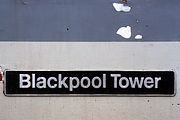 |
The Blackpool Tower nameplate on the side of 37407, photographed at Llandrindod Wells on 21 July 1999. The patches of peeling paint, and areas of rust do not present a very good impression, especially since it had only been six years since the loco acquired the triple grey freight livery. |
|
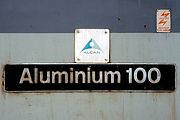 |
37410 received the name Aluminium 100 at the Alcan Works, Lynemouth on 21 September 1986, to mark the century of the aluminium smelting process. The nameplate is pictured, along with the Alcan logo plate, whilst the loco paused at Crianlarich on 28 April 1998. |
|
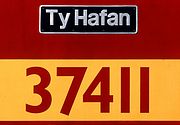 |
37411 was named Ty Hafan on 31 May 1997, at Newport station, in recognition of the work of Tŷ Hafan Children's Hospice. Although the circumflex accent mark over the letter y was incorporated on the replica plates presented at the unveiling, the plates on the loco did not carry it. It is pictured here at Rhymney on 1 May 1998. |
|
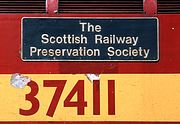 |
The Scottish Railway Preservation Society nameplate on 37411, photographed at Wick on 19 April 2003. The name had previously been applied to 37413. There are some serious paint issues here, with large chunks just falling off! |
|
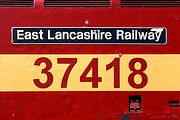 |
37418 was named East Lancashire Railway in April 1994. The nameplate is pictured at Wick on 19 April 2003, whilst the loco was working the Pathfinder Tours 'Orcadian' railtour. Appropriately the loco ended up at the East Lancs after it was withdrawn by EWS in 2008. |
|
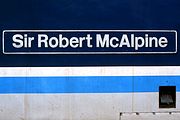 |
37425 was unusual in having a different nameplate on either side of the locomotive. The Sir Robert McAlpine plate is pictured here at Crianlarich on 27 April 1998. The other plate commemorates Sir Robert's nickname Concrete Bob, a name he acquired through his pioneering use of concrete in various construction projects, including the Glenfinnan Viaduct. |
|
 |
Sir Robert McAlpine earned the name Concrete Bob through his pioneering use of concrete (or reintroduction, as the Romans used a form of concrete 2,000 years ago!). 37425 carried this plate on one side of the loco, and a more conventional Sir Robert McAlpine on the other. It is pictured at Crianlarich on 27 April 1998. |
|
 |
Andromeda Rations! The placing of 37608's Andromeda nameplate above the Rail Operations Group wording on the loco's bodyside gives a slightly odd effect when a tightly cropped picture is taken. Note the Andromeda Constellation star map on the left of the nameplate. This is the first time that I have taken a nameplate picture whilst the train was moving. As the loco passed Broad Marston on 30 May 2020 with the 5Q91 13:40 Long Marston to Northampton EMD EMU move, I used a long lens to take this close up shot. A high shutter speed was obviously required, even though the train wasn't moving particularly fast, and some serious perspective correction in Photoshop was needed, but it worked surprisingly well. |
|
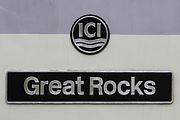 |
37688's Great Rocks Nameplate, photographed while the loco waited behind Honeybourne station on 7 September 2020 with the 5Z22 11:36 Long Marston to Crewe ECS. Because of where it was stopped, it was only possible to get this picture using a long lens, and photographing it through the station's waiting shelter window. However, that doesn't seem to have affected the quality at all! |
|
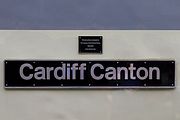 |
37714 was named Cardiff Canton at the Great Central Railway on 17 March 2017, in memory of Paul Fairfax (a Canton depot employee), as explained on the small additional plate. The nameplate was photographed at Leicester North station on 3 September 2022. |
|
 |
37884's Cepheus nameplate, photographed while the loco was stopped at Challow on 24 September 2021, whilst working the 5Q42 09:50 Ely Papworth Sidings to Newport Docks (Sims Group) stock move. Cepheus is a celestial constellation (which explains the graphics on the left), named after a king of Aethiopia in Greek mythology. |
|
 |
43002 received the named Sir Kenneth Grange on 2 May 2016, in honour of the man who gave the HST its distinctive streamlined shape. The famous designer was also responsible for a whole range of well known design icons, such as the Kodak Instamatic camera, and the Kenwood food mixer. The nameplate was photographed at Honeybourne on 24 February 2018, whilst the loco was working the 1W29 11:22 Paddington to Great Malvern GWR service. |
|
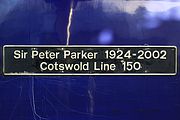 |
43127 received the name Sir Peter Parker 1924-2002 Cotswold Line 150 in September 2003, in recognition of Sir Peter's chairmanship of British Rail. Fittingly, this nameplate was photographed at his local station, Charlbury, on 30 November 2016. |
|
 |
The nameplate of 43172 Harry Patch - The last survivor of the trenches, pictured at Charlbury station on 18 April 2018. Harry Patch, was as the plate indicates, the last surviving soldier from the Great War, and also at one point the oldest man in Europe. He died, aged 111, in 2009. The coloured band on the nameplate represents Harry's eight medals: British War Medal, Victory Medal, Defence Medal, Légion d'honneur (Officer), Légion d'honneur (Chevalier), Order of Leopold, National Service Medal and the Hors de Combat Medal. |
|
 |
47323 was named Rover Group Quality Assured at the Rover car plant in Swindon on 23 February 1994. The nameplate is pictured here, along with the subsidiary Land Rover and Rover plates, moments after it was unveiled by Rover employee Wilf Rayner. The naming was to mark the signing of a new five year contract to move Rover cars by rail. Unfortunately, 47323 didn't manage to hang on to the name for that long! The plates were removed in July 1996, and later applied to 47236. |
|
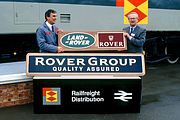 |
John Briffitt, Managing Director, Rover Body & Pressings (left), and Bill Shiplee, Railfreight Distribution's Commercial Director (right) show off the Rover Group Quality Assured nameplate at Rover's Swindon car body plant, at a special ceremony on 23 February 1994, just after 47323 had been named. |
|
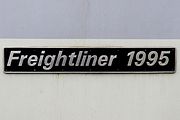 |
47376 received the name Freightliner 1995 at Crewe Basford Hall Yard on 28 August 1995. When the loco was preserved, instead of the usual two tone green or blue, it had its Freightliner branded grey livery reinstated. Therefore it was only fitting that the Freightliner 1995 plates should be reapplied. The plate is pictured here while the loco was stopped in Winchcombe station on 12 October 2019. |
|
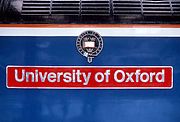 |
47547 was named University of Oxford on 3 October 1990 by the Oxford University Chancellor, The Right Honourable Lord Jenkins of Hillhead. The ceremony took place at Oxford station, and this picture shows the nameplate and crest just after the plastic covering had been removed but just prior to the curtains being placed in front ready for the unveiling. This was a double naming, along with 47587, and both locos made their way back light engine to Old Oak Common shortly after the event. |
|
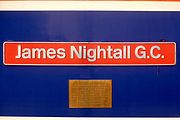 |
47579 was named James Nightall G.C. on 28 September 1981, to commemorate the fireman of a train of ammunition from Immingham, which caught fire near Soham on 2 June 1944. The quick thinking of the crew in uncoupling most of the 51 wagon train of bombs prevented a much worse disaster, although the explosion destroyed Soham station. The small plaque describes the event: One of two locomotives named after Driver B. Gimbert and Fireman J. Nightall of March who were awarded the George Cross for their action in saving the town of Soham from severe damage by a burning ammunition train on 2 June 1944. James Nightall was killed and Benjamin Gimbert received serious injuries. The nameplate was photographed at Cholsey on 16 August 1991. |
|
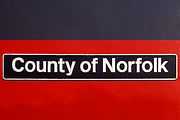 |
47170 was named County of Norfolk at Norwich station in August 1979. It retained the plates when converted to a 47/4 (47582) in 1981, and again when it was converted to a 47/7 (47733) in 1995, although it lost them after only a month, in favour of the name Eastern Star. The nameplate is pictured here against the parcels red and grey paintwork of 47582, at Kingham on 8 September 1991. |
|
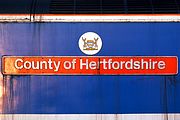 |
47583 was named County of Hertfordshire at Hertford East station in July 1979, when the locomotive was still numbered 47172. The nameplate and county crest are pictured here during its Network SouthEast days, at Radley on the evening of 20 July 1989. In 1993 the plates were transferred without ceremony to 47711. |
|
 |
47587 received the name Ruskin College Oxford at Oxford station on 3 October 1990. The nameplate is pictured here in the rain just after the covering had been removed, but before the crest had been uncovered. This is actually before the official unveiling, and the photo was quickly taken before the curtains were put in place! The unveiling was performed by Dr Stephen Yeo (Principal of Ruskin College). This was a double naming, along with 47547, and both locos made their way back light engine to Old Oak Common shortly after the event. |
|
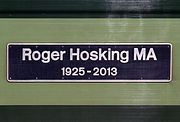 |
D1935 (47805)'s Roger Hosking MA 1925 - 2013 nameplate, pictured on 6 October 2021, whilst the loco was stopped in the loop at Challow, on the rear of the Saphos Trains 1Z60 06:40 Kidderminster to Bristol Temple Meads' Great Western Envoy' railtour. |
|
 |
50007 received the name Sir Edward Elgar on 25 February 1984, marking the fiftieth anniversary of the death of the celebrated English composer. At the same time the loco was controversially painted green to mark the 150th anniversary of the Great Western Railway. Nearly seven years later on 2 February 1991 the paintwork is in a very poor state, when seen here at Gillingham. Note how dark the original green paint scheme was, subtly different to its later repaints. Also note just how many screws are holding the nameplate on. Nobody is going to unscrew that in a hurry! |
|
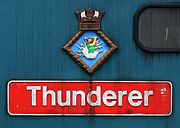 |
The nameplate and crest of 50008 Thunderer, photographed whilst the loco was stopped briefly at Challow on 16 November 2019, as it was working the 5Z41 12:42 Wembley to Bristol Barton Hill ECS. Off necessity this was taken with a long lens, from the field next to the line. |
|
 |
50015 was named Valiant on 24 April 1978, presumably after the then current nuclear powered submarine HMS Valiant, although in true Royal Navy tradition, the name had appeared on four previous ships (it was also allocated to another one which never actually got built). The nameplate is pictured at Bury, on the East Lancashire Railway, on 11 July 1998. |
|
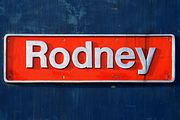 |
50021 received the name Rodney on 31 July 1978, commemorating the 1920s Royal Navy battleship HMS Rodney. The nameplate is pictured here at Toddington on 12 December 1992, shortly after the loco had arrived for its brief stay on the Gloucestershire Warwickshire Railway. |
|
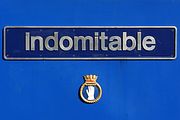 |
50026's Indomitable nameplate and crest, pictured at North Weald on 24 September 2017, whilst the loco was visiting the Epping Ongar Railway. The loco had standard red backed nameplates whilst in BR service, but then it never carried this later version of Network SouthEast livery in BR service either! |
|
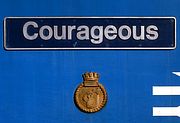 |
50032 Courageous was unusual in having dark blue backed nameplates instead of the more usual red. The blue plate and naval crest are seen here on the side of the Network SouthEast liveried loco at Oxford on 25 September 1987. |
|
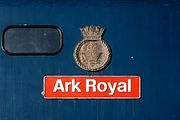 |
Commemorating a long line of Royal Navy warships bearing the name Ark Royal, starting with Sir Walter Raleigh's ship of 1587, 50035 received the name on 10 January 1978, becoming the first class member to carry a name. Initially it did not carry the crest shown here, but as these were fitted only a week later, I presume that pictures of the loco minus them are quite rare! Ark Royal is pictured here at Charlbury on 15 April 1983, with the bodywork showing signs of neglect. |
|
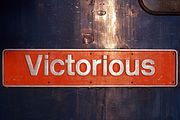 |
50036 was named Victorious in May 1978. Being a solid aluminuim casting, the plate still looks in good condition twelve years later, but the same cannot be said for the loco's bodywork! The low evening sun picks out all the brush marks of the hand painted finish, and more worryingly all the rust patches. This picture was taken at Heyford on 24 May 1990. |
|
 |
50044 was named Exeter at Exeter St Davids station on 27 April 1978 by Roger Keast, the local mayor, this despite the fact that the name refers to the Royal Navy Type 42 Destroyer HMS Exeter! However, to slightly redress the balance the naval crest was added on 20 August 1981 by Royal Navy Captain Dreyer. Originally the crest was positioned above the name, but with the application of Network SouthEast livery, the position was reversed. It is seen here in the latter guise, pictured at Paddington station on 22 November 1986. |
|
 |
50046 Ajax was in desperate need of a repaint (which it never got), when I photographed its nameplate at Templecombe on 21 August 1991. Note the position of the former crest. HMS Ajax, along with other Class 50 namesakes Exeter and Achilles, was involved in the hunting of the German cruiser Admiral Graf Spee, during the Battle of the River Plate in 1939. |
|
 |
50050 received the name Fearless on 23 August 1978. The slightly weather beaten nameplate and imposing crest are pictured at Oxford on 7 January 1984. I'm not sure why someone has tried embellishing the final three letters! |
|
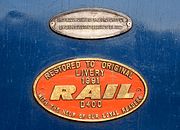 |
50050 was repainted into its original BR blue livery and given its original D400 number during early 1991 in order to mark the rundown of the class on BR. The loco lost its Fearless nameplate and instead gained this small Commemorative plaque on the bodyside. While scanning this slide and trying to accurately line up the image I realised that the lettering is not in the least level! Note also the English Electric Leasings plate, recalling the fact that initially the locos were not in fact owned by BR. Photographed at Yeovil Junction on 5 January 1992. |
|
 |
D400's English Electric works plate photographed at Yeovil Junction on 5 January 1992. Note that there is obviously no mention of the BR number, only the EE number 3770 and the works number D11411. The locomotive was handed over to BR on 3 October 1967, entering service a few days later. Only three other members of the class entered service during 1967, with the remainder arriving during 1968. The class was complete with the arrival of D449 (50049) in mid December 1968. |
|
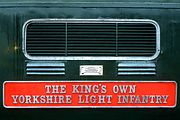 |
55002's The King’s Own Yorkshire Light Infantry (KOYLI for short) nameplate, pictured on 9 March 1997, at Bury Bolton Street, during the East Lancashire Railway's 'Three Deltics' weekend. The small plaque commemorates the painting of the loco back into green. |
|
 |
55015 (as D9015) received the name Tulyar at Doncaster Works on 13 October 1961. The plate is seen here on the preserved locomotive at Wansford on 6 October 1990. Tulyar was a famous racehorse of the 1950s, owned by the Aga Khan. Probably its most notable achievement was winning the 1952 Derby. |
|
 |
56123 was named Drax Power Station by R. J. Weeks, the director of CEGB Generation Division, at Drax Power Station on 11 May 1988. It was also fitted with a small CEGB logo plate, which was later replaced by a slightly larger National Power plate. Both these had gone by the time I photographed it at Cockenzie Power Station on 23 July 1996, leaving two sets of holes in the bodyside. |
|
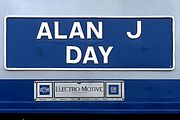 |
59002 was named Alan J Day by the man himself at Cranmore on the East Somerset Railway on 21 June 1996. The plate is pictured shortly after being unveiled, along with the EMD maker's plate, which includes the American manufacturer's serial number - 848002-2. |
|
 |
59004 was named Paul A Hammond by the man himself at Cranmore on the East Somerset Railway on 21 June 1996. The plate is pictured shortly after being unveiled, along with the EMD maker's plate, which includes the American manufacturer's serial number - 848002-4. |
|
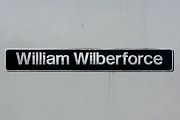 |
William Wilberforce was a nineteenth century British politician and social reformer, who led the campaign to abolish the slave trade. He was one of the famous people whose names were used for the new Class 60 fleet, the plates being applied to brand new 60046 at the Brush Works on 30 November 1990. It is good to see that nearly three decades later, the loco's new owner, DCR, have retained the name. The nameplate is pictured on 8 February 2020, whilst the loco was stopped in the loop at Challow whilst working the 5Z22 12:43 Wembley to Bristol Barton Hill DVT move. |
|
 |
66051's Maritime Intermodal Four nameplates, photographed while the loco was stopped at Challow on 29 November 2021, as it was working the 6C03 09:33 Northolt Sidings to Severnside Sita Binliner. The loco received the name in May 2019. |
|
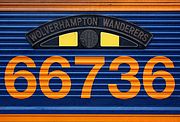 |
66736 received the name Wolverhampton Wanderers on 2 December 2011, one of a number of GBRf Class 66s to be named after football clubs. The nameplate is pictured whilst the locomotive paused briefly at Crianlarich on 31 August 2016, whilst working the 6E45 08:07 Fort William Alcan to North Blyth Alcan alumina empties. |
|
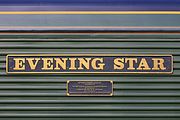 |
66779's Evening Star nameplate, photographed while the loco was stopped in the loop at Challow on 19 October 2020, whilst it was working the 6V32 10:23 Tilbury to Trostre Works steel empties. The small plaque describes how this was the last Class 66 to be built, and was named at the National Railway Museum in May 2016. Hopefully this loco will have a much longer life than the original BR 9F 2-10-0 Evening Star. That only lasted for just under five years. 66779 was just a few months short of that dismal record when this nameplate was photographed. |
|
 |
73126 received the name Kent & East Sussex Railway at Northiam station, on the eponymous railway, on 23 May 1991. The immaculate nameplate is pictured, also at Northiam station, just a few days later, on 27 May, whilst the loco was working passenger services on the line. The plates had been unveiled by Admiral Sir Lindsay Bryston, patron of the railway. |
|
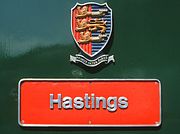 |
Hastings Diesels Ltd's Class 201 DMBSO 60000 from set 1001 has received the name Hastings in preservation. It is picture here, with appropriate crest at Uckfield on 25 May 1997. The Latin motto Primus inter pares translates as First among equals. |
|
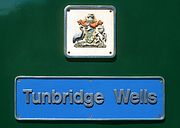 |
Hastings Diesels Ltd's Class 201 DMBSO 60118 from set 1001 has received the name Tunbridge Wells in preservation. It is picture here, with the Tunbridge Wells borough crest at Uckfield on 25 May 1997. The light blue backed nameplate is striking, and in marked contrast to 1001's other power car, 60000, which has a more conventional red backed Hastings nameplate. |
|
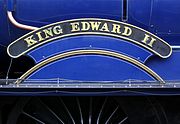 |
The experiential early British Railways blue livery of King Class 4-6-0 6023 King Edward II certainly show up well in this picture of one of the locomotive's nameplates, pictured at Toddington, on the Gloucestershire Warwickshire Railway, on 2 June 2018. King Edward II reigned from 1307 to 1327. |
|
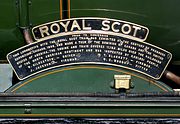 |
The nameplate of LMS Royal Scot Class 4-6-0 46100 Royal Scot, photographed on 6 October 2021, while the loco was taking a drink at Challow, as it worked the Saphos Trains 1Z60 06:40 Kidderminster to Bristol Temple Meads' Great Western Envoy' railtour. The rather short name is slightly overshadowed by the much large subsidiary plate diving details about the loco's trip to the USA in 1933. |
|
 |
The most famous locomotive in the world? LNER A3 4-6-2 4472 Flying Scotsman is certainly a well travelled locomotive, as the small plaque below the nameplate indicates. It commemorates a record breaking run in Australia in 1989. This picture was taken at Banbury station on 14 February 1992. |
|
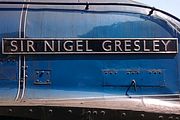 |
The nameplate of 60007 Sir Nigel Gresley pictured at Pickering, on the North Yorkshire Moors Railway on 5 June 2015. Whilst sister engine 60022 Mallard holds the world steam record of 126mph, Sir Nigel Gresley holds the post war speed record - 112mph, achieved at the same location as Mallard's famous 1938 run. |
|
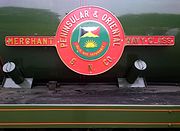 |
The nameplate of Southern Railway Merchant Navy Class 4-6-2 35006 Peninsular & Oriental S. N. Co., pictured at Cheltenham Racecourse station, on the Gloucestershire Warwickshire Railway, on 31 May 2016. If referred to by its full name (Peninsular & Oriental Steam Navigation Company), it has the longest name of any preserved steam locomotive. |
|
 |
One of the nameplates affixed to the smoke deflector of 7MT 4-6-2 70013 Oliver Cromwell, pictured at Toddington on the Gloucestershire Warwickshire Railway, on 2 June 2018. Oliver Cromwell was Lord Protector of the Commonwealth of England, Scotland, and Ireland, during the brief period when the countries were ruled as a republic. |
|
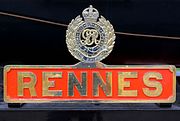 |
Robert Stephenson & Hawthorns Austerity 0-6-0ST WD152 was named Rennes whilst owned by the Longmoor Military Railway in the 1940s. It was latterly sold to the National Coal Board, and ended its days at Mountain Ash Colliery in 1979, a full decade after steam had finished on the mainline. Now fully restored at the Dean Forest Railway, the nameplate is pictured whilst the locomotive was at Lydney Junction on 16 July 2017. |
|
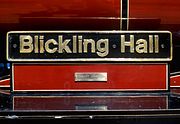 |
The nameplate of Bure Valley Railway 2-6-2 No.6 Blickling Hall, pictured at Aylsham on 1 June 1997. The loco commemorates the nearby stately home, which was designed by architect Robert Lyminge in the early seventeenth century. |
|
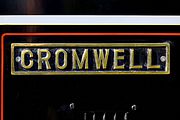 |
The nameplate of the Evesham Vale Light Railway's Ruston & Hornsby 4wDH 452280 Cromwell, pictured on 2 October 2016. Whilst it is quite clear that the BR 7MT 4-6-2 70013 Oliver Cromwell is named after England's only republican Commonwealth leader (1599-1658), this nameplate could equally well refer to Thomas Cromwell (1485-1540), King Henry VIII's political 'fixer'! |
|
 |
The nameplate of the Ffestiniog Railway's 2-4-0ST+T Blanche, photographed in the rain at Porthmadog on 1 May 2022. The loco is named after Blanche Georgina Fitzroy (1865-1944), wife of the owner of Penrhyn Quarry, the loco's original home. |
|
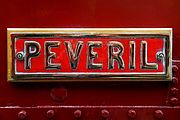 |
The Isle of Man Steam Railway's 1975 built Beyer, Peacock & Co. 2-4-0T locomotive No.6 was named Peveril after a character in Sir Walter Scott's novel Peveril of the Peak. The nameplate is pictured on 9 May 2017, in the Port Erin Museum. |
|
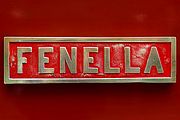 |
The nameplate of the Isle of Man Steam Railway's 2-4-0T steam locomotive No.8 Fenella, pictured during a very brief station stop at Port Soderick on 12 May 2017. Fenella is a character in Sir Walter Scott's novel Peveril of the Peak. |
|
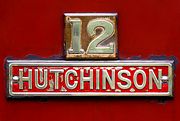 |
The Isle of Man Steam Railway's locomotive No.12 was named Hutchinson after the original company director William Hutchinson. The loco's nameplate is pictured at Castletown on 12 May 2017. Both the plate and the surrounding bodywork could do with a repaint! |
|
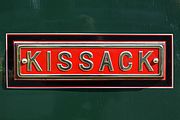 |
The Isle of Man Steam Railway's Beyer, Peacock & Co. locomotive No.13 was named Kissack after the original company director Edward Thomas Kissack, who was also a Manx MP. The loco's immaculate nameplate is pictured at Douglas station on 9 May 2017. |
|
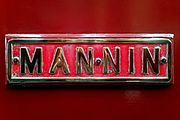 |
The nameplate of Isle of Man Steam Railway 2-4-0T locomotive 16 Mannin, picture inside the Port Erin Museum on 9 May 2017. Mannin was the last steam locomotive to be delivered to the island, arriving in 1926. Mannin is the Manx name for the Isle of Man. |
|
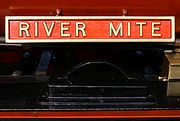 |
The nameplate of the Ravenglass & Eskdale Railway's 2-8-2 steam locomotive River Mite, pictured at Dalegarth on 26 May 2018. The River Mite follows the railway near the southern end of the line, joining the estuary of the River Esk near Ravenglass. |
|
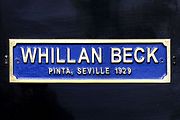 |
The Ravenglass & Eskdale Railway's newest acquisition, Krauss & Co 4-6-2 8457, was named Whillan Beck on 5 May 2018. It is named after the small stream that flows onto the River Esk near Beckfoot. The beck passes underneath the railway near Dalegarth station, where the nameplate was photographed on 26 May 2018. |
|
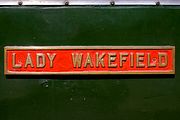 |
The Ravenglass & Eskdale Railway's diesel loco Lady Wakefield is named after the wife of the former chairman of the railway. The slightly battered looking nameplate was photographed at Dalegarth on 26 May 2018. |
|
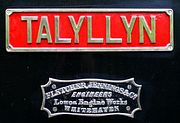 |
The Talyllyn's Railways 0-4-2ST 1 Talyllyn was built by Fletcher Jennings & Co of Whitehaven in 1864. Its nameplate is pictured here in the rain whilst the loco was waiting at Abergynolwyn station on 3 June 2012. |
|
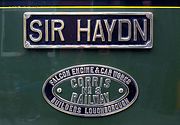 |
Former Corris Railway 0-4-2ST No.3 was named Sir Haydn in honour of the Talyllyn Railway's former owner Sir Henry Haydn Jones. The nameplate and loco works plate are pictured whilst the loco was at Tywyn Wharf on 30 April 2022. |
|
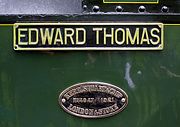 |
The Talyllyn Railway named ex-Corris Railway 0-4-2ST No.4 Edward Thomas in honour of the Talyllyn's manger when the loco arrived on the line in 1951. The nameplate and works plate are picture whilst the loco was at Abergynolwyn on 30 April 2022. |
|
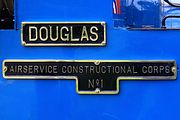 |
The nameplates on Talyllyn Railway 0-4-0WT 6 Douglas, pictured (whilst it was moving!) at Brynglas on 13 May 2022. As well as the original Douglas nameplate, the Air Service Constructional Corps No.1 plate was added to celebrate the centenary of the Royal Air Force in 2018. |